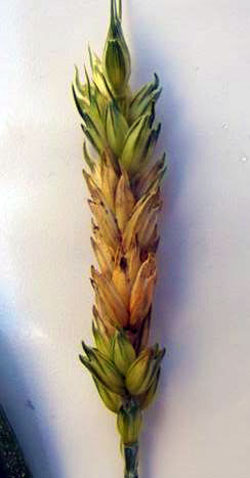In preparation for wheat harvest, growers are reminded to be prepared to take steps to help insure they achieve the best quality grain possible from their crop. The single biggest risk to quality so far this season is Fusarium head scab.
Despite aggressive fungicide use, the weather was simply too favorable in some locations for infections during the flowering stage. An extended flowering period, and thus infection period, due to irregular tiller development this spring may have also contributed to infection levels. Further, the recent stretch of warm, humid weather has been favorable for the disease to develop within the infected heads and, thereby, potentially generating more toxins.
Fusarium head scab tends to reduce test weight and can reduce grain yields to some extent. However, by far the overriding concern is that the disease can lead to the production of a mycotoxin, referred to as DON or vomitoxin.
Generally, the grain value is discounted when DON levels exceed 2 ppm in soft red wheat and 1 ppm in soft white wheat. Where these levels are greatly exceeded, the elevator may or may not accept the grain.
The following are some steps recommended by Michigan State University Extension that growers might consider when facing fields having potentially high levels of Fusarium head scab.

Separate high scab areas: Field areas that have been found to have higher levels of scab or DON through pre-harvest scouting, fungicide use records or DON tests at harvest. Also, be wary of lodged wheat or wheat located along tree lines.
Consult the manual: Combine adjustments should follow the manufacturer’s manual when first going to the field. Once in the field, operators should invest the time to sample the grain and make adjustments. The most important adjustments include concave clearance, screen openings and cylinder and fan speeds. This is particularly important when dealing with compromised grain quality. If it is determined that grain quality is not an issue, more conventional settings should be used to minimize grain loss.
Harvest moisture: Delaying harvest until the grain reaches 18 percent moisture helps insure scabby kernels will be threshed from the chaff and removed from the grain stream. However, delaying harvest should only be done where the grower is confident favorable weather will persist, as high moisture grain can continue to accumulate DON and there may be additional risk of pre-harvest sprouting if damp conditions return.
Harvest speed: Slower combine speed allows for increased separation of the scabby grain by avoiding occasional overloads and increasing exposure to the fan. This may be particularly important in lodged wheat.
Fan speed: Many, but not all, Fusarium-infected kernels are shrunken and have lower densities. Increasing the combine’s fan speed can greatly increase the number of lighter kernels blown out the back of the combine.
Keep records: Growers confronted with grain quality issues would do well to note any differences related to varieties and varietal susceptibilities; the use of fungicide products, timings and rates; and field histories and conditions. In addition, they should keep track of the DON tests performed on each load and relate them to the originating field and storage bin destination.
Grain drying: Grain should be dried to 13 or 14 percent as soon as possible, as DON can continue to develop in wet grain.
Storage: If possible, high DON wheat should be segregated. Also, special attention should be given to infected grain in storage. While the disease and toxin are stable in dry grain, the disease and toxin can further develop if moisture migrates and re-wets an area within the bin.
Source : msu.edu